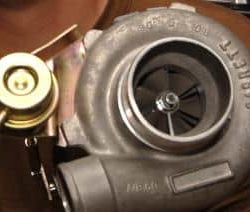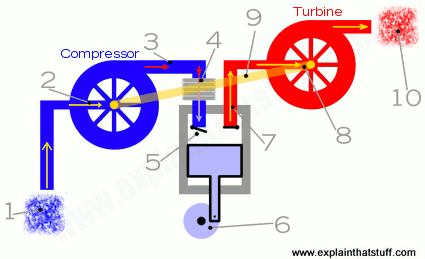How Does a Turbocharger Work?

Chances are, if you’re reading this blog you’re well aware of how to make your truck look badass with one of our headache racks and LED lights. Now that you’ve got the outside of your ride taken care of, it’s time to explore how to achieve some serious power under the hood.
Today, we’re exploring how a turbocharger works, along with some of the benefits.
How a turbocharger works
The basic idea is that the exhaust drives the turbine (the red fan), which is directly connected to (and powers) the compressor (the blue fan), which rams air into the engine. For simplicity, we’re showing only one cylinder. Here then, in summary, is how the whole thing works:
 Cool air enters the engine’s air intake and heads toward the compressor.
Cool air enters the engine’s air intake and heads toward the compressor.- The compressor fan helps to suck air in.
- The compressor squeezes and heats up the incoming air and blows it out again.
- Hot, compressed air from the compressor passes through the heat exchanger, which cools it down.
- Cooled, compressed air enters the cylinder’s air intake. The extra oxygen helps to burn fuel in the cylinder at a faster rate.
- Since the cylinder burns more fuel, it produces energy more quickly and can send more power to the wheels via the piston, shafts, and gears.
- Waste gas from the cylinder exits through the exhaust outlet.
- The hot exhaust gases blowing past the turbine fan make it rotate at high speed.
- The spinning turbine is mounted on the same shaft as the compressor (shown here as a pale orange line). So, as the turbine spins, the compressor spins too.
- The exhaust gas leaves the car, wasting less energy than it would otherwise.
(Source: explainthatstuff.com)
According to How Stuff Works,
“… a turbo can significantly boost an engine’s horsepower without significantly increasing its weight, which is the huge benefit that makes turbos so popular!
One of the surest ways to get more power out of an engine is to increase the amount of air and fuel that it can burn. One way to do this is to add cylinders or make the current cylinders bigger. Sometimes these changes may not be feasible — a turbo can be a simpler, more compact way to add power, especially for an aftermarket accessory.
Turbochargers allow an engine to burn more fuel and air by packing more into the existing cylinders. The typical boost provided by a turbocharger is 6 to 8 pounds per square inch (psi). Since normal atmospheric pressure is 14.7 psi at sea level, you can see that you are getting about 50 percent more air into the engine. Therefore, you would expect to get 50 percent more power. It’s not perfectly efficient, so you might get a 30- to 40-percent improvement instead.”
As kadekticaret.com simply puts it, “a turbocharger is basically an air pump… that gives your vehicle more ‘oomph.’
Still craving more information on turbos? Check out the video below for additional info:
Not totally convinced you’re ready for a turbo? No sweat! Keep exploring our headache racks, accessories and more and ensure your ride is totally up to par on the exterior.
